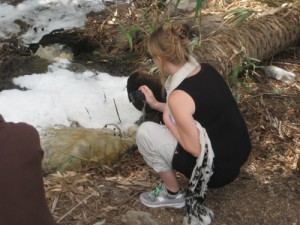 Although dust could fill up the Gulf in the next 20-40 years, according to scientists, at the moment it feeds the food chain. [image via treehugger]
Although dust could fill up the Gulf in the next 20-40 years, according to scientists, at the moment it feeds the food chain. [image via treehugger]
Whether from nearby construction zones puffing up plumes of dust and contaminating homes, or a sweeping sand storm, dust permeates every crevice of Middle Eastern life. But recent research suggests that dust swept into the Persian Gulf provides crucial nutrients that are then converted to organic carbon – necessary to fuel the marine ecosystem.
In regions blessed with rain and rivers, water feeds the ocean iron, phosphorous, and nitrogen, which in turn feeds cyanobacteria. But in Abu Dhabi, where water is scarce, wind transports approximately 5.5 million tonnes of dust to the Persian Gulf each year.
“It means that after 20 to 40 years, the Gulf will be filled up,” Dr Hamza, a senior biologist with UAE University, told the National.
This dust is driven from The Empty Quarter, the Hajar Mountains, as well as the coastal sabkhas, carrying nutrients that “under certain conditions, will dissolve out of the dust particle and into the sea water. More dissolves into the water the deeper the particles are submerged,” writes journalist Vesela Todorova.
Although this is good, and necessary to stimulate algae growth, in 2008 too much dust caused a large algae bloom that not only disrupted the local fishing industry, but local desalination plants as well. Instead of waiting at the bottom of the ocean for nutrients to sink, an influx of nutrients brought by the most excessive dust storms in 10 years seduced huge swaths of algae blooms to the surface causing a “red tide.”
Dr Anbiah Rajan, an associate scientist for marine ecology at the Environment Agency – Abu Dhabi, said he was unable to comment on Dr Hamza’s findings until they were published in a scientific peer-reviewed paper. But he confirmed that his own research suggested a link between dust storms and blooms of Cyanobacteria, also known as blue-green algae.
If confirmed, these findings will finally explain the long-standing puzzle of how the Persian Gulf receives the nutrients necessary to support its food chain.
:: The National
More Environmental Stories From Abu Dhabi:
Gulf Emirates Spending Billions on Defense When Their Environment Suffers
Abu Dhabi’s Costly Desalination Plants Prompt Wastewater Treatment Plans
Abu Dhabi Municipality Launched Successful Paper-Less Day Campaign



